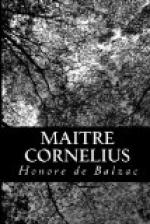The grand provost had scarcely reached the embankment leading to Plessis, when the count and his wife, both mounted, she on her white mule, he on his horse, and followed by two pages, joined the archers, in order to enter Plessis-lez-Tours in company. All were moving slowly. Georges was on foot, between two guards on horseback, one of whom held him still by the leathern thong. Tristan, the count, and his wife were naturally in advance; the criminal followed them. Mingling with the archers, the young page questioned them, speaking sometimes to the prisoner, so that he adroitly managed to say to him in a low voice:—
“I jumped the garden wall and took a letter to Plessis from madame to the king. She came near dying when she heard of the accusation against you. Take courage. She is going now to speak to the king about you.”
Love had already given strength and wiliness to the countess. Her laughter was part of the heroism which women display in the great crises of life.
In spite of the singular fancy which possessed the author of “Quentin Durward” to place the royal castle of Plessis-lez-Tours upon a height, we must content ourselves by leaving it where it really was, namely on low land, protected on either side by the Cher and the Loire; also by the canal Sainte-Anne, so named by Louis XI. in honor of his beloved daughter, Madame de Beaujeu. By uniting the two rivers between the city of Tours and Plessis this canal not only served as a formidable protection to the castle, but it offered a most precious road to commerce. On the side towards Brehemont, a vast and fertile plain, the park was defended by a moat, the remains of which still show its enormous breadth and depth. At a period when the power of artillery was still in embryo, the position of Plessis, long since chosen by Louis XI. for his favorite retreat, might be considered impregnable. The castle, built of brick and stone, had nothing remarkable about it; but it was surrounded by noble trees, and from its windows could be seen, through vistas cut in the park (plexitium), the finest points of view in the world. No rival mansion rose near this solitary castle, standing in the very centre of the little plain reserved for the king and guarded by four streams of water.
If we may believe tradition, Louis XI. occupied the west wing, and from his chamber he could see, at a glance the course of the Loire, the opposite bank of the river, the pretty valley which the Croisille waters, and part of the slopes of Saint-Cyr. Also, from the windows that opened on the courtyard, he saw the entrance to his fortress and the embankment by which he had connected his favorite residence with the city of Tours. If Louis XI. had bestowed upon the building of his castle the luxury of architecture which Francois I. displayed afterwards at Chambord, the dwelling of the kings of France would ever have remained in Touraine. It is enough to see this splendid position and its magical effects to be convinced of its superiority over the sites of all other royal residences.




